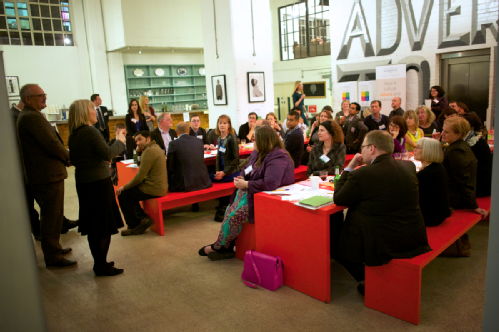Introductory Meeting - 27th November 2013

On 27th November the Warwick Commission kick-started its investigation into the future of cultural value with an introductory meeting that brought together Commissioners, the Academic Reference Group and cultural professionals. The inspiring and unusual setting of Mother London's headquarters in the Biscuit Building in Shoreditch provided a suitably creative backdrop for the evening’s lively debates. The Commission Team would like to thank everyone who came along and shared their thoughts and suggestions for the Commission. Whilst it would be impossible to do justice to the broad scope of discussions around the room, we have tried to capture below some of the dominant ideas across the strands. The Commission Team will, however, consider all comments and suggestions when reviewing the outcomes of the evening.
If you would like to respond to any of these points, please email warwickcommission at warwick dot ac dot uk and we will make sure that your viewpoint is shared with the Commission.
Disconnects
The discussions on ‘valuing culture’ identified two disconnects. The first was found in public perceptions of culture. It was suggested that the general public frequently associate ‘culture’ with ‘high art’ and therefore do not immediately realise that culture, in its various manifestations, is relevant to their lives. A ‘rebranding’ of culture, similar to that of feminism, which takes in a more complex definition of culture would perhaps help the public to identify the value of culture to them.
The second was found within the sector itself, which requires more ‘joined-up thinking’ to make its voice heard. Networks such as ‘What next?’, which connects smaller and larger cultural organisations, can amplify and add weight to the arguments put forward by the sector. The disconnect in relation to ‘education and talent’ lay in the research surrounding this theme. It was suggested that longitudinal study is required rather than short bursts of research that are arranged to tie in with politicical lifecycles. A shift in research methods to include longitudinal study would allow us to study the impact of cultural education ‘from playground to pension’. Moreover, investigations in this area, including the Commission’s work, must ensure that their recommendations are concrete and implementable rather than generalised arguments in favour of arts education that remain detached from political reality. To this end, it is important to recognise the vital role played by headteachers, who are the most important commissioners of cultural education for school-age children.
Finally, discussions relating to the fourth strand on ‘international trends’ called for the Commission to overcome certain geographical disconnects. A segmented view of culture that divides the UK into its four nations was criticised. Furthermore, although it was recognised that the Commission’s focus is founded in a desire to cover adequately the complex set of questions surrounding cultural value, it was noted that the Commission must take care to ensure full representation of England itself with its myriad of different cultural and sub-cultural communities. It was also suggested that studies need to focus more on the connections between the regional and the global, considering how global trends affect regional practices and how these, in turn, affect global trends.
Definitions
Defining value is equally important and will, in fact, form a significant part of the second strand. It was pointed out that value and investment are not synonymous, as the latter is specific to its context and implies the expectation of a ‘return’. The fact that value is commonly expressed in econometric terms is not necessarily unhelpful; however, these terms must be broadened beyond money if we are to assess accurately the value of culture. Participants in the discussions around first strand suggested that it may be useful to analyse arts investment through various business models (e.g. dynamic pricing, mixed economy, disintermediation, social investment).
It was also suggested that the question headings for each strand could be phrased in more helpful terms and this is a priority for the Commission Team moving forward.
Digital Technologies
Access
The relationship between class and access was dealt with both implicitly and explicitly. In particular, those involved in the third strand asked how we can create structures for young people who care about culture from backgrounds where their parents/carers do not have the syntax or experience to engage with cultural activities. This is a question that the Commission intends to address across several of its strands and it is reassuring to know that our discussions will reflect broader concerns across the sector.
The ways in which people of different ages engage with and value culture were also discussed. The request for a longitudinal study of the impact of creative education in the third strand was echoed in the first strand’s call to explore the ways in which young people invest in culture and how this evolves. Across the board, exposure to the arts during childhood was identified as a crucial factor in widening access under the motto ‘If I can see it, I can be it’.
